 |
Focus features two in-depth reviews each month of fine art, architecture and design exhibitions and events at art museums, galleries and alternative spaces around Japan. The contributors are non-Japanese art critics living in Japan. |
|
|
 |
 |
 |
Sublime Harmonies: Bunkyo's Trove of Mechanical Music
Susan Rogers Chikuba |
 |
 |
|
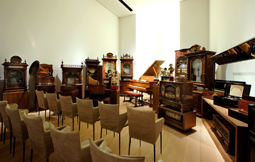 |
| The guided tour of the permanent and changing exhibits concludes with tea or coffee in the cafe, where player pianos channel George Gershwin's own rendition of "Rhapsody in Blue," Maurice Ravel playing "Bolero," and performances by Camille Saint-Saens and others. Admission to the concert hall includes demonstrations of half of the 30 or so devices on display, with commentary in Japanese. |
"Why travel around so glum and so blue when you can jolly up for a nickel or two?" So beckons the coin-operated, early 20th-century Hexaphone on display in the cafe of the Museum of Mechanical Musical Instruments in Tokyo's Bunkyo Ward. Made in the U.S. by Regina Co. of Rahway, New Jersey, this phonograph's proud claim to fame is the advanced storage capacity suggested by its name: it offered the patrons of bars and other places where it was installed as many as six songs to choose from.
Retired from production in 1921, the Hexaphone is in fact one of the more modern items on exhibit in the privately owned and wonderfully conceived museum. The 350-piece collection of street organs, automata, cylinder boxes, disc boxes, player pianos, and more explores the history of musical recording and playback -- from the invention of the music box by Swiss watchmaker Antoine Favre in 1796 to Thomas Edison's breakthrough phonograph of 1877 and onward to the advent of electronic recording in 1925, which effectively rendered most spring-wound music players obsolete.
 |
|
 |
| At the current exhibition featuring cylinder boxes, gadget mavens can learn about compression springs, air brakes, ratchet wheels, and motor barrels. The artistically inclined, meanwhile, may enjoy the concurrent display of six hand-colored prints from Marc Chagall's The Bible series. All are encouraged to lie down on the custom-designed bench -- it's attached to a Polyphon disc box from the 1890s -- to soak up the warm vibrations of analog sound. |
Curator Yoshihito Namura began showing his treasure trove of mechanical devices in his home in the late 1970s, taking appointments by phone. As word spread, the number of inquisitive music lovers and nostalgia buffs showing up at his door on weekends compelled him to turn his passion into a full-time enterprise. Orugoru no Chiisana Hakubutsukan ("A Small Museum of Music Boxes") opened in Mejirodai in 1983 with 50 rare pieces from Switzerland, Germany, and America in its holdings. Despite its modest name, the venture was hardly small in scope. The museum was the only venue of its kind in Japan (perhaps in all of Asia), and visitors received Namura's studied explications of each model's significance within the larger history of industrial craft. Today, Namura and his daughter Asuko, who manages the museum, are the go-to people in Japan for all things music box-related. In 2003 they rebuilt on the site, adding an intimate concert hall and repair facilities to three floors of galleries that house permanent, changing, and special exhibits.
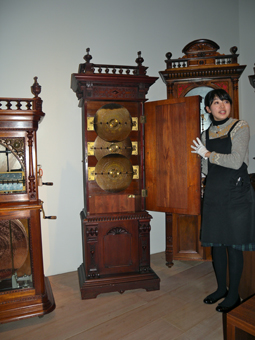 |
|
 |
| Ayame Kudo demonstrates the "Eroica" by Symphonion, a landmark machine that played three discs simultaneously for harmonic sound. Made in Germany between 1886 and the 1920s, disc players such as this replaced costly handmade cylinder boxes, as any number of tunes could be played on a single machine by simply changing the mass-produced discs. The museum's proud display of its "software" -- antique discs and piano rolls -- holds some 4,000 songs. |
If you tend to think of a music box as a diminutive thing that sits on the shelf and plays a tinkling excerpt from some cliched tune, that's not what you'll find here. The Namuras' galleries are filled with hefty pieces of furniture that once graced the halls of handsome mansions and entertained patrons of pubs and other gathering places. Encased in hand-carved wood cabinets replete with corner finials, gilt-lined door panels of beveled glass, and frontispieces of blind fretwork backed with red velvet, these predecessors of the jukebox housed ingeniously designed mechanisms that gave their 19th- and 20th-century owners music on demand. Decorative fittings such as clocks and artistic lithographs were optional, and part of a robust mail-order business back in the day.
The delicate engineering of musical movements is the focus of an exhibition showing at the museum through March 10 and featuring a dozen cylinder boxes, the epitome of music-box handicraft prior to machine-made mass production. First produced in Switzerland in the 1830s, these elegant spring-motor devices took Favre's steel comb and rotating cylinder to new heights, adding mechanisms for sustained tremolos, high piccolo notes, variations in volume, and the playing of long stanzas without interruption. Some are fitted with drums and bells. The rich, clear tones of these players are as much a tribute to bygone craftsmanship as to the museum's careful preservation of these sensitive devices -- the angle of each tiny pin is crucial to the accuracy of the score. Watching the cylinders turn, their pins catching the light, it's easy to fall under the same magic spell that inspired the Namuras to share this world with others.
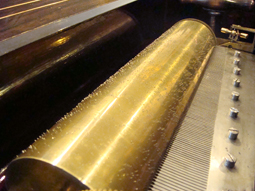 |
|
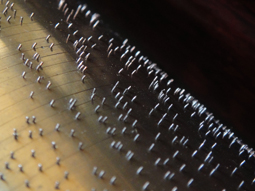 |
| As the cylinder rotates, its thousands of pins strike the steel teeth of the comb, sounding notes. These close-ups of an 1840 piece by Le Coultre & Granger reveal the mind-boggling complexity of fashioning whole orchestral overtures from tiny studs whose height, angle, and placement determine the quality of each single note. First made in Switzerland in the 1830s, cylinder boxes were widespread by the 1880s but were made obsolete by the disc box. |
If winter's cold has got you down, head to Mejirodai for the happy injection of charm these instruments provide. (All demonstrations are scheduled, but you can book online before you go. Mark your calendar now for the series of special Christmas concerts planned December 19 to 24!) Visitors with a romantic bent will delight in the nostalgia, those with technical leanings will admire the ingenuity, and history buffs will enjoy the story behind the rise and fall of these antique marvels. It's just the sort of foray into the esoteric that makes Tokyo so endearing.
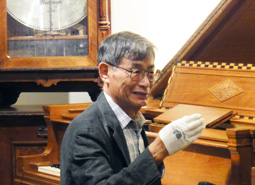 |
|
In this day of digital downloads and personal music players that hold more songs than we'll listen to in a lifetime, we've come a long way. Or have we? Yoshihito Namura named his company enterprise Ars Longa, from Vita brevis, ars longa -- the Latin translation of Hippocrates' observation that artistic craft outlives us all.
All images courtesy of, or by permission of, the Museum of Mechanical Musical Instruments |
|
|
|
|
 |
 |
Susan Rogers Chikuba
Susan Rogers Chikuba, a Tokyo-based writer, editor and translator, has been following popular culture, architecture and design in Japan for 25 years. She covers the country's travel, real estate, hospitality and culinary scenes for domestic and international publications. |
|
 |
|